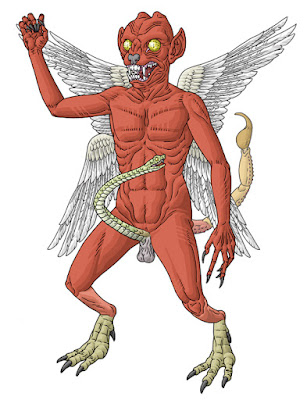Friday, May 27, 2022
MERCURIUS
Thursday, May 26, 2022
MINOTAUR
Wednesday, May 25, 2022
CAMAZOTZ
“In the Quiché Popol Vuh, the Underworld Camazotz or “death bat,” cuts off the head of the Hero Twin, hunahpu.”
Mary Miller & Karl Taube, The Gods and Symbols Of Ancient Mexico and the Maya
“Camazotz; A vampire bat god of the Quiché Maya in Guatemala. They Maya considered him a terrible god who served death and ruled twilight. He lived in the bloody caverns and other dark places that people tried to avoid for fear of disturbing him.”
Ann Bingham & Jeremy Roberts, South and Meso-American Mythology A to Z
“He is said to have a leaf-like nose, an anthropomorphized bat whose name evoked fear of darkness and the unknown.”
Sebastian Berg, Maya Mythology
Tuesday, May 24, 2022
QUINOTAUR
Monday, May 23, 2022
AMMUT
Friday, May 20, 2022
CHNOUBIS
Thursday, May 19, 2022
GLYCON
“In the middle of the 2nd century CE, on the shore of the Black Sea, any visitor could have had his future foretold by a divine snake with a human-like head, called Glycon. The serpent and his prophet Alexander were so respected, even the philosopher-emperor Marcus Aurelius asked them for help.”
“The serpent’s head looked out from Alexander’s beard and it bore a striking resemblance to a human face.
Viktor Susnyak, Glycon, The Fake Snake Oracle and Alexander, His Prophet
“When they went in, the thing, of course, seemed to them a miracle, that the formerly tiny snake within a few days had turned into so great a serpent, with a human face, moreover, and tame!”
Lucian Of Samosata, Alexander The False Prophet
“The next morning he leapt forth into the city’s marketplace frenziedly hailed the city as blessed for being on the point of receiving the manifestation of the god, ran to the temple side and scooped around in the mud until he dredged up the egg, breaking it in his hand to reveal the young snake, to the amazement of the bystanders, who raised a shout, welcomed the god, called the city blessed, and cried out prayers for riches and health.”
“The marble and the bronzes portray Glycon as a rampant snake with sami-humanoid face and human hair, compatibly with Lucian’s description of the god. They also tell us things Lucian does not, namely that Glycon wore his hair long in the Pythagorean fashion of his sponsor, that he boasted prominent humanoid ears with which to heed his petitioners, and a final tail that was either bifurcated, trifurcated or leonine.”
Daniel Ogden, Drakon: Dragon Myth and Serpent Cult In the Greek and Roman Worlds
Wednesday, May 18, 2022
PAZUZU
H.W.F. Saggs, The Babylonians
“Pazuzu is represented in statuettes and engravings with bulging eyes in a canine face, a scaly body, snake-headed penis, the talons of a large bird, and enormous wings.”
Joshua J. Mark, World History Encyclopedia
“He stands on two legs and has human arms ending in claws, with two pairs of wings, a scorpion's tail, a snake-headed, erect penis, and a horned, bearded head with bulging eyes and snarling canine mouth.“
Sarah Graff, Pazuzu: Beyond Good and Evil
Tuesday, May 17, 2022
LEONTOCEPHALINE GOD
“The Mithraic lion-man was usually depicted entwined by a serpent with the serpent's head resting on his leonine visage, which often appeared menacing if not infernal. The lion-man was variously portrayed with keys and scepters.”
Yuri Stoyanov, The Other God: Dualist Religions From Antiquity to the Cathar Heresy
Monday, May 16, 2022
ABRAXAS
“In describing Abraxas, C. W. King says: "Bellermann considers the composite image, inscribed with the actual name Abraxas, to be a Gnostic Pantheos, representing the Supreme Being, with the Five Emanations marked out by appropriate symbols. From the human body, the usual form assigned to the Deity, spring the two supporters, Nous and Logos, expressed in the serpents, symbols of the inner senses, and the quickening understanding; on which account the Greeks had made the serpent the attribute of Pallas. His head--that of a cock--represents Phronesis, that bird being the emblem of foresight and of vigilance. His two arms hold the symbols of Sophia and Dynamis: the shield of Wisdom and the whip of Power."
Manly P. Hall, The Secret Teachings Of All Things
Friday, May 13, 2022
DEMON-LIKE SEA MONSTER
"In the same year (1427), a sea monster was caught and its image was distributed in the country. The upper part up to the navel was of human shape and below it was a fish. Except that the lower part was divided in two, lengthwise. It had, above the ears two growths similar to horns. It had two large breasts and a wide mouth. From the hands to under the armpits and further to the belly it had webbing suitable for swimming. So this monster was trapped: In a city by the sea there were several women walking on the shore, and to one of them - the same cruel beast came and wanted to drag to him. But the woman resisted splendidly and asked the other women for help. These ran up and seized and slew the monster with sticks and stones and pulled it ashore. it was so ghastly to behold that many were frightened by it. Its length and size were more than that of a man. It is thought to have come to the town to eat, for many children of the town who had gone swimming in the sea were lost in it and never returned. therefore they must have been eaten by the beast.
Thursday, May 12, 2022
VLÉTIF
Wednesday, May 11, 2022
SIRENA
Tuesday, May 10, 2022
SIREN-LIKE DOLPHIN II
Monday, May 9, 2022
SIREN-LIKE DOLPHIN I
Aristotle, Historia Animalium
Sunday, May 8, 2022
DUNGEON COMPENDIUM I & II HALF GONE!
DUNGEON COMPENDIUM I & IILIMITED TO 30 COPIES
Illustrated by Michael Bukowski
- 12 pages each.
- 20 full color illustrations.
- 8.5"x 5.5" format.
- Hand numbered.
- Hand signed.
- Hand assembled.
















